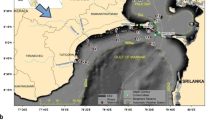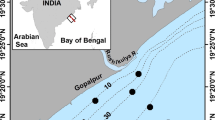Abstract
Fluorescence line height (FLH) is a relative measure of the amount of radiance leaving the sea surface in the chlorophyll fluorescence emission band. Satellite-derived FLH images provide information about the surface chlorophyll distribution which in turn can be used for monitoring surface phytoplankton blooms in coastal waters. The present study aims at observing a phytoplankton bloom in the Kakinada coastal waters along the east coast of India using nFLH product of MODIS-A. This quasi-permanent bloom could not be precisely observed using chlorophyll concentration in the turbid coastal waters due to the presence of other optically active constituents; hence, chlorophyll fluoresce is used to study the bloom phenomenon from nFLH product of MODIS. The analysis has been carried out by analysing the spectral variability using both in situ and satellite Rrs spectra over the bloom and non-bloom waters. Comparative study between in situ chlorophyll with satellite-derived FLH showed a good correlation with an R2 of 0.43. The bloom phenomenon observed/assessed from the MODIS nFLH data showed > 0.25 W m−2 sr−1 μm in the bloom-dominated pixels. This proves that the satellite-derived nFLH can also be used as an indicator in detecting the phytoplankton blooms and also as one of the important parameters for the ocean colour applications in case-II waters.








Similar content being viewed by others
References
Abbott, M. R., & Letelier, R. M. (1999). Algorithm theoretical basis document chlorophyll fluorescence (MODIS product number 20). NASA. http://www.modis.gsfc.nasa.gov/data/atbd. Accessed 7 Aug 2019.
Behrenfeld, M. J., Westberry, T. K., Boss, E. S., O’Malley, R. T., Siegel, D. A., Wiggert, J. D., et al. (2009). Satellite detected fluorescence reveals global physiology of ocean phytoplankton. Biogeosciences, 6, 779–794.
Fiorani, L., Okladnikov, I. G., & Palucci, A. (2006). First algorithm for chlorophyll-a retrieval from MODIS-Terra imagery of Sun-induced fluorescence in the Southern Ocean. International Journal of Remote Sensing, 27, 3615–3622.
Fischer, J., & Kronfeld, U. (1990). Sun-stimulated chlorophyll fluorescence 1: Influence of oceanic properties. Remote Sensing, 11(12), 2125–2147. https://doi.org/10.1080/01431169008955166.
Gordon, H. R., & Wang, M. (1994). Retrieval of water-leaving radiance and aerosol optical thickness over the oceans with SeaWiFS: A preliminary algorithm. Applied Optics, 33(3), 443–452.
Gower, J. F. R., & Borstad, G. A. (1990). Mapping of phytoplankton by solar-stimulated fluorescence using an imaging spectrometer. International Journal of Remote Sensing, 11(2), 313–320.
Gower, J. F. R., Doerffer, R., & Borstad, G. A. (1999). Interpretation of the 685 nm peak in water-leaving radiance spectra in terms of fluorescence, absorption and scattering, and its observation by MERIS. International Journal of Remote Sensing, 9, 1771–1786.
Gower, J. F. R., Hu, C., Borstad, G. A., & King, S. (2006). Ocean color satellites show extensive lines of floating Sargassum in the Gulf of Mexico. IEEE Transactions on Geoscience and Remote Sensing, 44, 3619–3625.
Gower, J. F. R., & King, S. (2007a). Validation of chlorophyll fluorescence derived from MERIS on the west coast of Canada. International Journal of Remote Sensing, 28, 625–635.
Gower, J. F. R., & King, S. (2007b). An Antarctic ice-related ‘superbloom’ observed with the MERIS satellite imager. Geophysical Research Letters, 34, L15501.
Gower, J. F. R., King, S., Borstad, G. A., & Brown, L. (2005). Detection of intense plankton blooms using the 709 nm band of the MERIS imaging spectrometer. International Journal of Remote Sensing, 26, 2005–2012.
Gunther, K., Ernst, D., & Maske, H. (1986). Biophysical processes of chlorophyll a fluorescence. In The use of chlorophyll fluorescence measurements from space for separating constituents of sea water (ESA Contract No. RFQ 3-5059/84/NL/MD, Volume II). Geesthacht, F.R. Germany: GKSS-Forschungszentrum Geesthacht.
Hoge, F. E., Lyon, P. E., Swift, R. N., Yungel, J. K., Abbott, M. R., Letelier, R. M., et al. (2003). Validation of Terra-MODIS phytoplankton chlorophyll fluorescence line height. I. Initial airborne Lidar results. Applied Optics, 42, 2767–2771.
Hu, C., & Feng, L. (2016). Modified MODIS fluorescence line height data product to improve image interpretation for red tide monitoring in the eastern Gulf of Mexico. Journal of Applied Remote Sensing, 11(1), 012003. https://doi.org/10.1117/1.JRS.11.012003.
Hu, C., Cannizzaro, J., Carder, K., Lee, Z. P., Muller-Karger, F. E., & Soto, I. (2011). Red tide detection in the eastern Gulf of Mexico using MODIS imagery. In Handbook of satellite remote sensing image interpretation: applications for marine living resources conservation and management (pp. 95–110).
Hu, H., Wang, J., Liu, H., & Goes, J. (2016). Simulation of phytoplankton distribution and variation in the Bering-Chukchi Sea using a 3-D physical biological model. Journal of Geophysical Research Oceans, 121, 4041–4055. https://doi.org/10.1002/2016JC011692.
Letelier, R. M., & Abbott, M. R. (1996). An analysis of chlorophyll fluorescence algorithm for the Moderate Resolution Imaging Spectrometer (MODIS). Remote Sensing of Environment, 58(2), 215–223. https://doi.org/10.1016/S0034-4257(96)00073-9.
Nagamani, P. V., Latha, T. P., Rao, K. H., Suresh, T., Choudhury, S. B., Dutt, C. B. S., et al. (2015). Setting of cloud albedo in the atmospheric correction procedure to generate the ocean colour data products from OCM-2. Journal of the Indian Society of Remote Sensing, 43(2), 439–444.
Nagamani, P. V., Preethi Latha, T., Bhavani, I. V. G., Rao, Y. U., Raman, M., Amminedu, E., et al. (2017). Optical detection of daitom bloom in the coastal waters of Bay of Bengal using Oceansat-2 OCM. National Academy of Sciences, 1, 2. https://doi.org/10.1007/s40010-017-0455-5.
Neville, R. A., & Gower, J. F. R. (1997). Passive remote sensing of phytoplankton via chlorophyll a fluorescence. Journal of Geophysical Research, 82, 3487–3493.
O’Reilly, J. E., Maritorena, S., Mitchell, B. G., Siegel, D. A., Carder, K. L., Garver, S. A., et al. (1998). Ocean color chlorophyll algorithms for SeaWiFS. Journal of Geophysical Research, 103, 24937. https://doi.org/10.1029/98JC02160.
Pegaue, S., Zaneveld, J. R. V., Mitchell, B. G., Muller, J. L., Kahru, J. M., Wieland, J., et al. (2003). Inherent optical properties: Instruments, characterization, field measurement and data analysis protocols. In J. L. Muller, G. S. Fargion, & C. R. McClain (Eds.), Ocean optics protocols for satellite ocean colour validation, revision 4. Greenbelt, MD, USA: NASA, Goddard Space Flight Center.
Preethi Latha, T., Nagamani, P. V., Rao, B. S., Amarendra, P., Rao, K. H., Choudhury, S. B., et al. (2013). Particle backscattering variability in the coastal waters of Bay of Bengal: a case study along off Kakinada and Yanam regions. Geoscience and Remote Sensing Letters, 10(6), 1517–1521.
Preethi Latha, T., Nagamani, P. V., Rao, K. H., Dash, S. K., Choudhury, S. B., Rehman, A., et al. (2014). Retrieval and validation of chlorophyll-a concentrations in the coastal waters Off Yanam and Kakinada (Godavari) basin along East coast of India. Journal of Indian Society of Remote Sensing, 42, 129–138. https://doi.org/10.1007/s12524-013-0282-3.
Rao, T. D. V. P., Latha, T. P., Rao, K. H., Choudhury, S. B., & Nagamani, P. V. (2012). Processing of Oceansat-2 ocean colour monitor data using SeaDAS. NRSC/ECSA/AOSG/OSD/December-2012/TR-488.
Timmermans, R. K., Vander Woerd, H. J., Wernand, M. R., Sligting, M., Uitz, J., & de Baar, H. (2008a). In situ and remote sensed chlorophyll fluorescence as indicator of the physiological state of phytoplankton near the Isles Kerguelen (Southern Ocean). Polar Biology. https://doi.org/10.1007/s00300-007-0398-4.
Timmermans, K. R., Van der Woerd, H. J., Wernand, M. R., Sligting, M., Uitz, J., & De baar, H. J. W. (2008b). In situ and remote based chlorophyll fluorescence as indicator of the physiological state of phytoplankton near the Isles Kerguelen (Southern Ocean). Polar Biology, 31, 617–628.
Acknowledgements
The authors would like to thank Dr. Shantanu Choudhury, Director, National Remote Sensing Centre (NRSC), and Dr. M. V. R. Sesha Sai, Deputy Director, Earth and Climate Science Area (ECSA). Thanks are also due to all the participants of the cruise and their respective collaborative support institutions for extending their support to carry out the experiments. This work is supported under NICES programme. We thank the anonymous reviewers for providing comments that helped to improve the quality of the original manuscript.
Author information
Authors and Affiliations
Corresponding author
Additional information
Publisher's Note
Springer Nature remains neutral with regard to jurisdictional claims in published maps and institutional affiliations.
About this article
Cite this article
Umamaheswara Rao, Y., Nagamani, P.V., Baranval, N.K. et al. Detection of Phytoplankton Blooms in the Turbid Coastal Waters Using Satellite-Derived Fluorescence Line Height off Kakinada Coast. J Indian Soc Remote Sens 47, 1857–1864 (2019). https://doi.org/10.1007/s12524-019-01022-5
Received:
Accepted:
Published:
Issue Date:
DOI: https://doi.org/10.1007/s12524-019-01022-5




